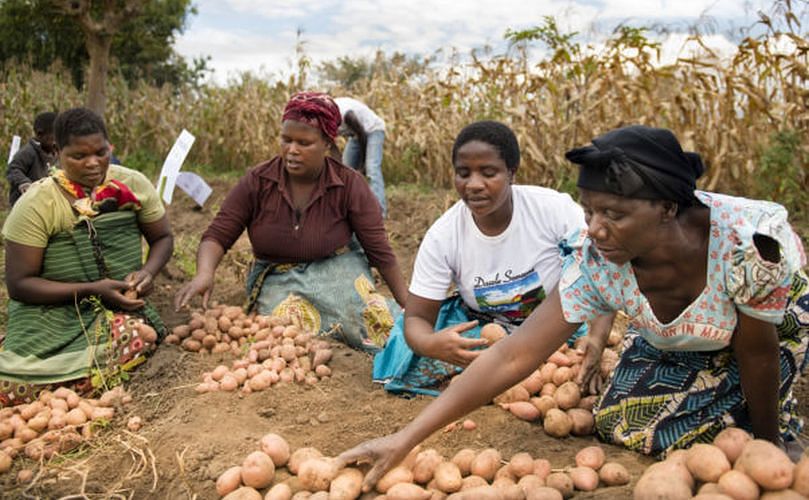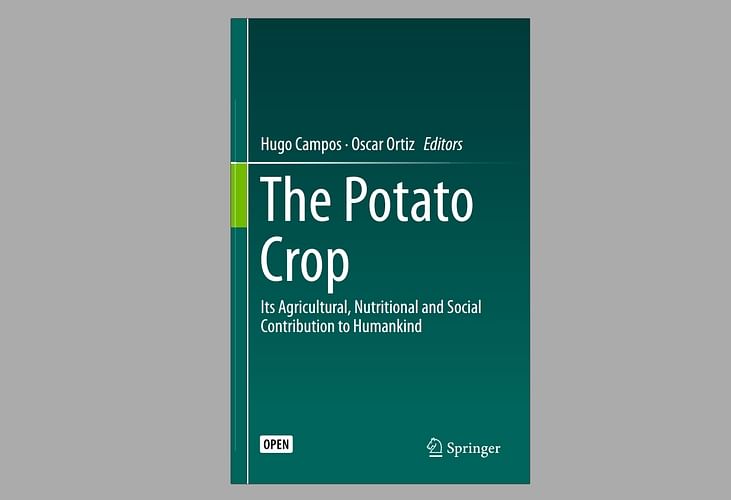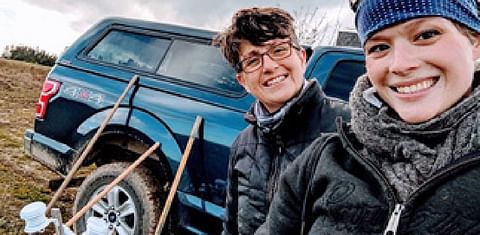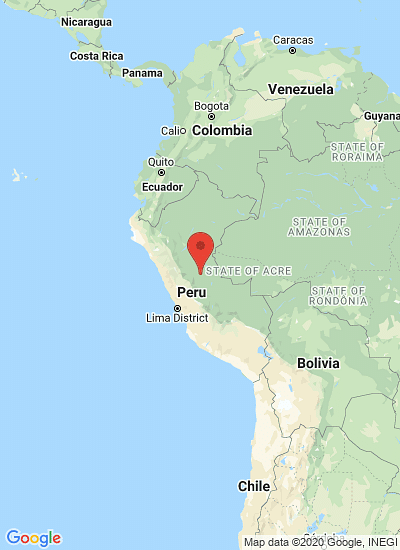An interview with the editors of the book, Dr. Hugo Campos (left), Director of Research and Oscar Ortiz (right), CIP’s Deputy Director General of Research and Development at the International Potato Center.
'The Potato Crop' Receives Enthusiastic Reception: An Interview with Co-Editors

The Potato Crop is a unique 14-chapter, end-to-end treatment of the potato, co-edited by two leading scientists at the International Potato Center (CIP): Oscar Ortiz, the Deputy Director General for Research and Development, and Hugo Campos, the Director of Research.
To the delight (and surprise) of its many authors, the open access volume has been downloaded more than 56,000 times in its first month from the Springer publishing website. Within the domain of scientific books, it has become a best seller.
The book covers all aspects of the potato from the basic science of its growth and physiology to the role it plays in food security, development, gender transformation, and climate change resilience for smallholder farmers in developing countries around the world.
Each chapter emphasizes the need to work in a participatory way to connect disciplines, farmers, scientists and organizations.
To learn more about the book, and reflect on its early success, Christopher Butler, CIP’s Managing Editor, sat down with Campos and Ortiz for an interview at the CIP headquarters in Lima.
*****
Q: What inspired this book? What are the origins of the idea behind The Potato Crop?
Campos:
“It was quite simple. To maximize the reach of our research to as many people as possible. That’s why, right from the beginning, we planned for this to be an open access book. We also wanted it to be available free of charge to everyone.
Also, we originally planned to publish only in English, but the early success has convinced us to translate the volume into Spanish and that edition will be available soon.
Secondly, we wanted to develop a book that, in one way or another, conveyed CIPs main messages. Our work is not only about science or agronomy or breeding. For this reason, the book has a healthy amount of social science focusing on gender, participatory research, economics and value chains, for example.
So, these were the two main drivers… to convey a perspective beyond just agronomics. And to make the content as widely available as possible. And frankly, I have to admit, so far, we are really flattered and grateful for this enthusiastic reception.
Not even in our wildest dreams did we think the book would over 56,000 downloads in 1 month. We’re very pleased about the visibility for CIP and potato scientists.
And I’m also pleased that the book features much collaboration. If you review the authors, you’ll see that only half are CIP scientists. The rest are from our many partners around the world in companies, universities, and other research institutions.”
Q: Following up on that… what are the qualities of this book that draw so much interest?
Ortiz:
“It’s the potato. Not many people know that it’s the third most-commonly consumed crop in the world. In China and India, it is a staple, but we find developing countries eating more potato now because of its nutrition and agronomic benefits. Also, developing countries are already producing more potatoes than developed ones.”

Q: I like that the book talks about the “circle” of the potato… it starts with the basic science but then broadens the picture to talk about the socio-economic implications of potatoes. Bearing that in mind, what misunderstanding about potatoes do you find persist? And what does the book do to address those misunderstandings?
Campos:
“There are quite a few, unfortunately. Particularly in developed countries, there is a 'guilt by association' connection between the potato and obesity when, in reality, the opposite is true. Scientific research has shown that potatoes are a valuable source of protein, fiber, vitamins and minerals when boiled or baked prior to eating.
Unfortunate, this [misunderstanding] has had impact on fundraising for our research. Some organizations that are very willing and generous to fund agricultural research in other crops do not have the same willingness to fund work on potato.
Secondly, in many countries, but particularly in Africa, potato represents a significant source of income for smallholder farmers. It’s not just about food security. If we can more effectively convey this information about potato, I think we will be able to put potato back into the place it deserves.
Third, the traditional varieties of potato have long growing cycles. From 120-140 days from planting to harvest. And that’s just too long for many farmers and many food systems. At the moment, CIP breeders are developing several varieties with life cycles under 100 days and we’re working very hard to develop varieties that mature in 80 days or less so that they will fit in nicely with rice-based and wheat-based systems in Asia.”
Q: What’s the role of the potato in agro-biodiversity?
Ortiz:
“Potato is one of the most effective and successful ways to put biodiversity in practice. Let me explain… I am a big believer in the paramount importance of biodiversity, but it has to be put in service of humankind through varieties. Otherwise, it just exists in a genebank and it doesn’t create value to smallholders.
From that perspective, most of the genes that we are breeding into more common potatoes are coming from landraces and most of them from the Andes. Several breeding teams at CIP have worked to develop iron biofortified potatoes, okay? Those genes come directly from landraces.
That is a great example of biodiversity put into practice. At the end of the day, we deliver better nutrition and better incomes through the ability to channel genetic diversity from landraces and potato wild relatives into varieties of cultivated potatoes.”
Q: I want to ask you about the role of potatoes in climate change resilience. It may not be an easy association for people to make, but there is an association to be made. What is it?
Campos:
“Naturally, potato is a climate resilient crop, perhaps not as much as sweetpotato. However, the breeders at CIP have been able to increase the climate-resilience of potatoes. We have made these varieties available to farmers in several parts of the world.
These varieties can withstand drought and heat stress. To give you an example, we just released a variety in India called Kufri Lima that we developed in partnership with colleagues at the Central Potato Research Institute (CPRI). Kufri Lima is much more heat tolerant that previous varieties.
So, as you can see, potato can play a significant role in climate change resilience with smallholders to secure their well-being.
Also, we just talked about shorter life cycles for new varieties? Those shorter life cycles for potatoes also indirectly contribute to smallholder climate resilience by allowing them to produce more food in a shorter amount of time.”
*****
In the coming months, Campos and Ortiz plan to continue publicizing the book, hoping the ideas contained within will transform into tangible results for potato growers around the world.
Campos:
“We want to see the content put into practice.”
“At the end of the day, we don’t want this book to stay in the office.”
Access the book online
To access the book online, or to download individual chapters as pdf, Go here











